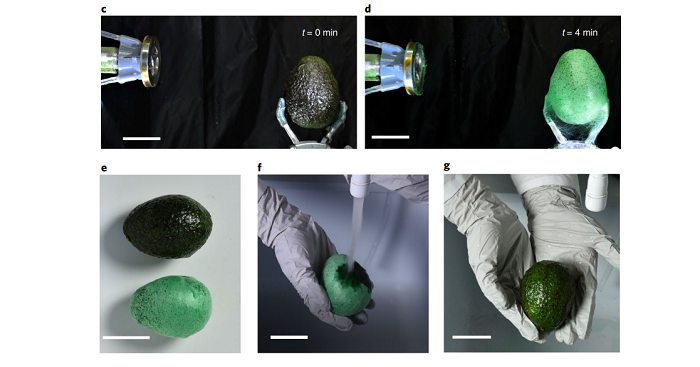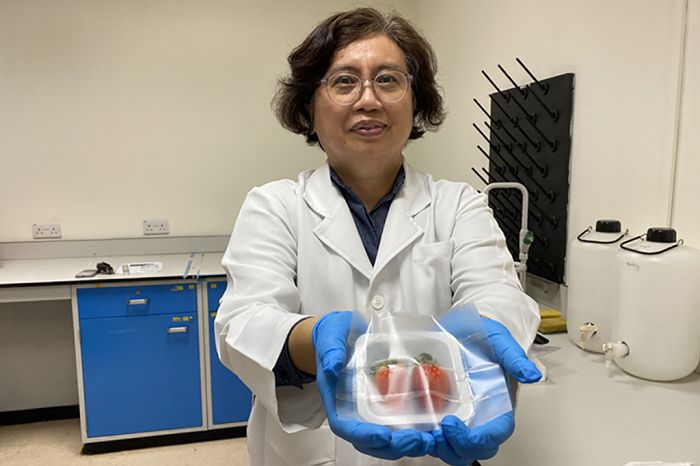ISABEL RUBIO ARROYO | Tungsteno
As food prices continue to rise and a potential global food crisis looms, nearly a third of all food produced each year is thrown away or spoils before it is consumed, according to the World Food Programme. A team of scientists are aiming to put an end to this problem with a new plant-based food packaging material that aims to combat food spoilage and the growth of pathogenic micro-organisms. We look at the potential and limitations of their promising findings, published in the scientific journal Nature Food.
Battlefield-inspired packaging
"We knew we needed to get rid of the petroleum-based food packaging that is out there and replace it with something more sustainable, biodegradable and nontoxic," says Philip Demokritou, director of the Nanoscience and Advanced Materials Research Center, a scientist at Rutgers University and one of the study's authors. This led him to the question: "Can we design food packaging with a functionality to extend shelf life and reduce food waste while enhancing food safety?"
His team set to work. Together with some scientists from Harvard University, they aimed to develop "new-generation 'smart' and 'green' food packaging". They created a scalable technology to turn biopolymers—macromolecules that can be plant-based and derived from food waste—into smart fibres that can wrap food directly. "We are harnessing advances in materials science and materials processing to increase both the longevity and freshness of the food items and doing so in a sustainable model," says Kit Parker, professor of bioengineering and applied physics at Harvard University's School of Engineering and Applied Sciences.
The new food packaging system has its roots in battlefield medicine. Parker and his team had previously developed antimicrobial fibres for wound dressings. "As it turned out, wound dressings have the same purpose, in some ways, as food packaging: maintaining tissues, protecting them against bacteria and fungi, and controlling moisture," explains Huibin Chang, another of the study's authors.
Scientists around the world have been searching for years for ways to create sustainable packaging to replace plastic. Credit: American Chemical Society
Wrapping food the Spider-Man way
Using this material, the result resembles a web-wrapped fruit. "Like the webs cast by the Marvel comic book character Spider-Man, the stringy material can be spun from a heating device that resembles a hair dryer and “shrink-wrapped” over foods of various shapes and sizes, such as an avocado or a sirloin steak," explains science news portal EurekAlert. The food wrapping material can be rinsed with water and degrades in soil within three days, according to the study.
In theory, the material is tough enough to protect avocados from bruising. In addition, it contains antimicrobial agents to combat spoilage and pathogenic microorganisms such as E. coli—bacteria that can cause serious food-borne illness—and listeria, another bacteria that can be found in a variety of raw, processed and unpasteurised milk-based foods and can cause listeriosis. The fibres wrapped around the food are combined with natural antimicrobial ingredients such as thyme oil, citric acid and nisin. The aim, according to Demokritou, is for these materials to act as sensors and destroy bacterial strains to extend the shelf life of food.

Researchers have developed a new material for packaging avocados that aims to extend their shelf life. Credit: Nature Food.
Extending the shelf life of fresh avocados and strawberries
In tests conducted by the study's authors, the material extended the shelf life of avocados by 50%. Despite the potential of this solution, it has one major drawback: the economic and technical challenges of making it scalable. This is the main challenge facing researchers trying to create sustainable packaging to replace plastic. Nevertheless, Demokritou is upbeat: "There are a lot of companies focusing on developing sustainable technologies and materials. And I’m very optimistic that we will see an escalation of their use in many products in the near future."
It is true that there are many promising examples. For example, as reported in research published in the journal ACS Applied Materials & Interfaces, a team of scientists has created a 'smart' packaging material that uses biodegradable corn protein, starch and other naturally occurring biopolymers. In one experiment, strawberries wrapped in the material stayed fresh for seven days before developing mould, compared to four days for those in typical plastic fruit boxes.

A team of scientists investigates how to keep foods like strawberries fresher for longer. Credit: Harvard School of Public Health.
Green solutions in the age of plastic
Plastics are one of the biggest threats to the environment because they rarely biodegrade. As a review published in Environmental Toxicology and Pharmacology explains, they typically break down into microplastics and nanoplastics through different processes and end up in the air, rain, snow and Antarctic ice, the oceans and even our diet. Demokritou stresses that "over the past 50 to 60 years, during the Age of Plastic, we’ve placed 6 billion metric tonnes of plastic waste into our environment. They are out there degrading slowly. And these tiny fragments are making it into the water we drink, the food we eat and the air we breathe," he says.
Although numerous researchers are working to replace plastic, many of the most promising projects to create sustainable packaging have not yet left the lab and have yet to scale up and reach the mass market. This is no easy task, and especially so in this case, as these researchers are looking to solve one of the great challenges of the century: minimising spoilage and waste to provide safe and nutritious food for the world's growing population.
· — —
Tungsteno is a journalism laboratory to scan the essence of innovation. Devised by Materia Publicaciones Científicas for Sacyr’s blog.
